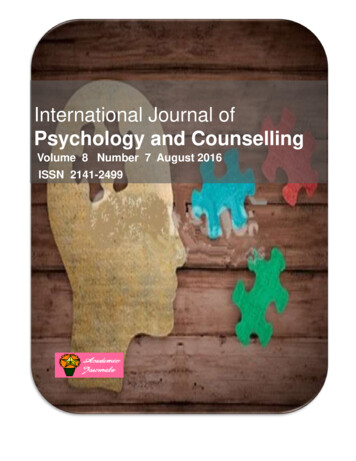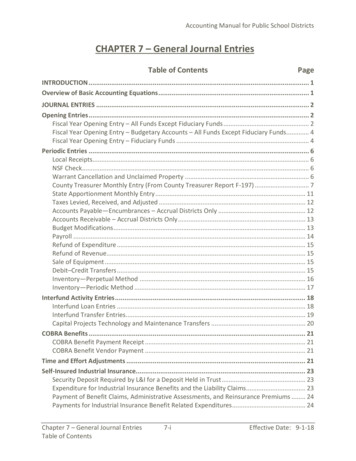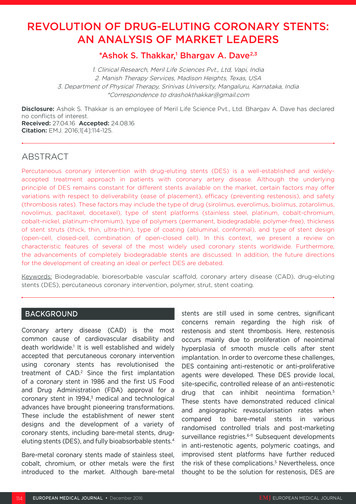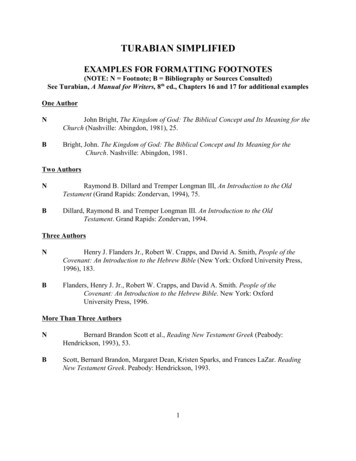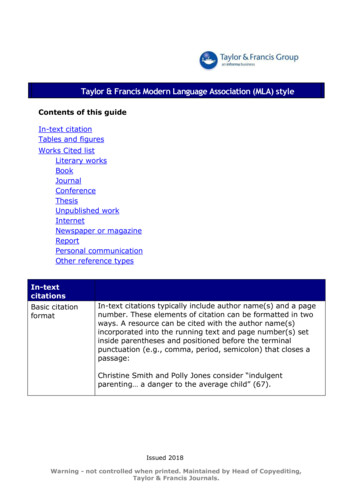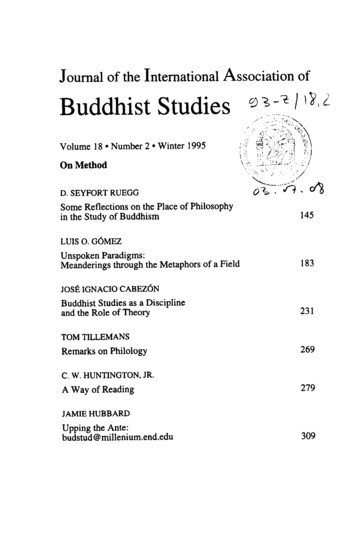
Transcription
Journal of the International Association ofBuddhist Studies -*/ z'Volume 18 Number 2 Winter 1995On Method' . .''- " ""',g x" \l '»!#;&' ?j\ . :''i.m --l'-'- -'/' x:N'' C «0 . c/g D. SEYFORT RUEGGSome Reflections on the Place of Philosophyin the Study of Buddhism%\' ; /145LUIS O. G6MEZUnspoken Paradigms:Meanderings through the Metaphors of a Field183JOSE IGNACIO CABEZ6NBuddhist Studies as a Disciplineand the Role of Theory231TOM TILLEMANSRemarks on Philology269C. W. HUNTINGTON, JR.A Way of Reading279JAMIE HUBBARDUpping the Ante:budstud@millenium.end.edu309
JOSE IGNACIO CABEZ6NBuddhist Studies as a Disciplineand the Role of TheoryIs Buddhist Studies a discipline, or is it still in a proto-disciplinary phasein its evolution? Or is it rather a super-disciplinary entity that serves as ahome for disciplines? What is the relationship of Buddhist Studies to the(sub)disciplines from which it draws? Does Buddhist Studies requirehomogeneity for its coherence and perpetuation as a field of academicinquiry? Does it in fact have such homogeneity? The last decade hasbeen witness to the rise of a body of theoretical literature whose purposeit is to explore the notion of disciplinarity.] How do disciplines arise?What social, institutional and rhetorical practices are employed in theconstruction of their sense of coherence and unity? What are their natural subdivisions? How do disciplines change, and how do they respondto changes in the intellectual climate? How do they interact with one another? These are just some of the questions raised in the field that hascome to be known as "disciplinary studies," and the first goal of thisAn earlier version of this paper was presented at the Institut fiir Kultur undGeschichte Indiens und Tibets, Universitat Hamburg in the summer of 1994; ithas benefited from the comments of colleagues and students alike; I wouldespecially like to thank Prof. D. Jackson for his close reading, and Mr. B.Quessel and Dr. F.-K. Ehrhard for their valuable bibliographical suggestions.It was also presented as a keynote address at the meeting of the InternationalAssociation of Buddhist Studies, Mexico City (November, 1994), in responseto which I must acknowledge not only the comments of the various colleagueswho heard the paper, but also the valuable bibliographical references suppliedto me by Profs. T. Tillemans and J. Bronkhorst, by Dr. U. Pagels and byProf. Jamie Hubbard. The paper was written during the tenure of anAlexander von Humboldt fellowship. The author wishes to express his gratitude to the von Humboldt Stiftung (Bonn) for its generous financial support.1 The most recent study, with an extensive bibliography of previous work inthe field, is Ellen Messer-Davidow, David R. Shumway and David J. Sylvan,eds., Knowledges: Historical and Critical Studies in Disciplinarity(Charlottesville and London: University of Virginia Press, 1993).231
232JIABS 18.2essay is to reflect on Buddhist Studies in light of this recent body ofliterature.The second goal derives from the first and is in a sense more urgent.If, as I think is clear, divergent methodological approaches to the studyof Buddhism are emerging, then the time has come for us to seriouslyconsider these alternative methodologies and to ask what role methodological reflection should play in the field today. For the past severalyears different approaches to the study of Buddhism have emerged thatchallenge what they take to be the classical paradigm. How the latter ischaracterized, of course, determines the nature of the critique. In someinstances classical Buddhology is portrayed as overly concerned with aspecific geographical area (usually India). The domination of the fieldby the given area is said to have two consequences: (1) by equating thestudy of Buddhism with its study in the specific geographically hegemonic area, classical Buddhology has been charged with impairing thedevelopment of areas of research—Chinese, Tibetan and Southeast AsianBuddhist Studies, for example—as subdisciplines in their own right, and(2) it makes of the study of the languages and civilizations of these otherareas mere tools to the study of the dominant cultural region.2 But thecritique of the classical paradigm in Buddhist Studies can take other2. That the study of Indian Buddhism is hegemonic in this regard—thatscholars of the latter consider the study of Chinese texts as worthwhile only tothe extent that it serves to elucidate Indian Buddhism—is a point made mostrecently by T. Griffith Foulk, "Issues in the Field of East Asian BuddhistStudies: An Extended Review of Sudden and Gradual: Approaches toEnlightenment in Chinese Thought," Journal of the International Associationof Buddhist Studies 16.1 (1993): 93-180. The point is also made byLancaster; see note 18. It is not difficult to see why in reading Nagao Gadjin,for example, a scholar of Tibetan Buddhism should share Foulk's view concerning the dominance of Indian / Sanskritic based scholarship in the field. InNagao's "Reflections on Tibetan Studies in Japan," Acta Asiatica: Bulletin ofthe Institute of Eastern Culture 29 (1975): 107-128, he states that "Tibetan isno more than a complement to Sanskrit Buddhist studies, though a veryimportant complement" (p. 112). See also de Jong's remarks concerning thecentrality of Indian Buddhist texts in Buddhist Studies in his "Recent BuddhistStudies in Europe and America: 1973-1983," Eastern Buddhist 17.1 (1981):82. On the relationship of the study of Indian and Tibetan Buddhism inJapan, and the methodological shifts that have taken place in recent years seeMatsumoto Shiro, Tibetan Studies in Japan: 1973-1983, Asian Studies inJapan, 1973-1983, Part 11-18 (Tokyo: The Centre for East Asian CulturalStudies, 1986).
CABEZ6N233forms as well. There are those who claim, for example, that the fieldfocuses almost exclusively on written, doctrinal texts to the exclusion ofother semiotic (that is, meaning-producing) forms (e. g., oral texts, epigraphical and archaeological data, rituals, institutions, art and socialpractices).3 In some instances the critique goes further, not only bemoan 3. Many scholars in the history of the field have stressed the importance ofconsidering more than written textual data. This has traditionally taken theform of advocating the study of epigraphy, art, ritual, culture, "Buddhistmentality," etc., alongside, or as supplements to, textual material. E. Burnouf,arguably the father of Buddhist Studies, himself used epigraphical material toshed light on the meaning of words and phrases in the texts he studied; see hisextensive tenth appendix to Le Lotus de la Bonne Loi (Paris: Maissoneuve,1825). On other studies of Buddhist inscriptions see J. W. de Jong, "A BriefHistory of Buddhist Studies in Europe and America," Eastern Buddhist 8.1:88; and, by the same author, "Recent Buddhist Studies" p. 98. The most recentliterature, however, dissatisfied with this more moderate stance, criticizes thehegemony of the written text over other semiotic forms and attempts to showhow a serious engagement with the latter undermines many of ons of the field. Paradigmatic ofthis approach is the work of Gregory Schopen. See especially his "TwoProblems in the History of Indian Buddhism: The Layman / Monk Distinctionand the Doctrines of the Transference of Merit," Studien ?,ur Indologie undIranistik 10 (1985); "The Stupa Cult and the Extant Pali Vinaya," Journal ofthe Pali Text Society 13 (1989); and "Burial kad Sanctos' and the PhysicalPresence of the Buddha in Early Indian Buddhism," Religion 17 (1987): 193225. Of course, as Schopen himself acknowledges, there are earlier instancesof such a critique, most notably Paul Mus's classic study Barabudur: esquissed'une histoire du Bouddhisme fondie sur la critique archiologique des textes(Hanoi: cole Francaise d'Extreme-Orient, 1935; New York: Arno Press,1978; Paris: Arma Artis, 1990). Schopen's critique is not limited, however,to the use of epigraphical and archaeological data, as can be seen from his"Monks and the Relic Cult in the Mahaparinibdnnasutta: An Old Misunderstanding in Regard to Monastic Buddhism," Koichi Shinohara and GregorySchopen, eds., From Beijing to Benares: Essays on Buddhism and ChineseReligion (Oakville: Mosaic Press, 1991) 187-201, where he utilizes writtentexts themselves to undermine the received wisdom of classical Buddhology.Steven Collins, Selfless Persons: Imagery and Thought in Theravada Buddhism (Cambridge: Cambridge University Press, 1982), considers social practices, that is, "the actual thought and practice of most Buddhists," to be indispensable to the understanding of "intellectual Buddhism": "I have tried toshow that the most abstract forms of its (Buddhism's) imaginative representations—what we call its 'ideas'—are intimately connected with, and inextricable from, the presuppositions and institutional framework of Buddhist culture
234JIABS 18.2ing the narrowness of the data traditionally considered (a critique of con tent) but also attacking the traditional means of studying the data that isconsidered (a critique of method). The latter often takes the form of arepudiation of classical Buddhist philology, seen by its detractors as anaive and scientistic approach to the study of written texts. 4 In otherinstances, traditional Buddhology is seen as overly narrow in its scope—in its hyperspecialization, unconcerned with broader, comparative questions and unable to enter into dialogue with the wider intellectualcommunity. 5and society" (p. 265-266).4. Examples include C. W. Huntington with Geshe Namgyal Wangchen, TheEmptiness of Emptiness: An Introduction to Early Indian Mddhyamika(Honolulu: University of Hawaii Press, 1989), and Andrew P. Tuck, Comparative Philosophy and the Philosophy of Scholarship: On the Western Interpretation of Nagarjuna (New York and Oxford: Oxford University Press,1990). For a brief critique of specific methodological principles used in thephilological analysis of Buddhist texts see Paul Griffiths' review of LambertSchmithausen's Alayavijnana, in the Journal of the International Associationof Buddhist Studies 12.1 (1989): 170-177. See also John C. Holt, Buddha inthe Crown: Avalokites'vara in the Buddhist Traditions of Sri Lanka (New Yorkand Oxford: Oxford University Press, 1991) viii.5. See, for example, Paul J. Griffiths, "Buddhist Hybrid English: Some Noteson Philology and Hermeneutics for Buddhologists," Journal of the International Association of Buddhist Studies 4.2 (1981): 18, for example, where hestates that "there is absolutely no reason why Buddhology should become anhermetic tradition, sealed off from the uninitiate and passed down from masterto pupil by mystical abhiseka', in that way lies extinction, or at least a selfbanishment from the wider academic community." Griffiths goes on to assertthat the understanding of Buddhism "goes far beyond philology" (p. 18),involving as it does the hermeneutical task, which requires that scholars restatethe meaning of texts in words other than those of the texts themselves. Thishe perceives as leading to "some very positive results in the area of inter-disciplinary and inter-cultural thinking" (p. 21). Consider also Steven Collins'remarks in Selfless Persons p. 1, "I think that a great deal of contemporaryphilosophy, particularly in the English-language tradition, suffers from a lackof historical and social self-awareness. I want to argue that philosophicalreflection should not proceed in abstraction from intellectual history andanthropology, from the investigation and comparison of cultures." DavidSeyfort Ruegg, "Some Observations on the Present and Future of BuddhistStudies," Journal of the International Association of Buddhist Studies 15.1(1992): 105, encourages not only interdisciplinarity, "the need to foster contacts with specialists from other disciplines," but also "a closing of the ancientand entrenched divide between 'town' and 'gown' by attracting and holding
CABEZ6N235Reaction to this challenge has varied. In some cases, it has beenignored: a North American,6 postmodern ripple on the otherwise calmsea, one that will dissipate with time. In others, it has brought scorn andfear: what will become of "serious" scholarship in light of these recentdevelopments? The second goal of this essay is to explore thesemethodological differences and to suggest not a means of achieving reconciliation (none, I think, is forthcoming), but a way of living withthese differences that averts an impending—and possibly irreparable—rift within the field.It may be inappropriate to call Buddhist Studies a discipline, especiallyif we take disciplines to be exemplified by such fields as history, anthropology, art history and so forth. Analogous to the Buddhist argumentconcerning the self and the aggregates, it might be contended that Buddhist Studies is not a discipline because it contains disciplines as parts.7This, however, could simply be a question of historical evolution, forthere was a time when even the classical disciplines did not seem particu larly disciplinary-like. The fact that Buddhist Studies today seems athe educated attention, interest and support of persons who are not full-timeprofessional academics"; see also the latter's remarks concerning specializationand interdisciplinarity in "A propos of a recent contribution to Tibetan andBuddhist Studies," Journal of the American Oriental Society 82 (1962): 322,n. 4.6. That the critique emerges primarily out of North America can be gleanedfrom the sources cited in the previous four notes. Increasingly, many buddhologists based in North American institutions of higher education see themselves as having a distinctive style—a method of scholarship that is differentfrom that which is represented by the parent discipline. Increasingly, NorthAmerican scholars seek to create a self-identity by contrasting their work withthat of their European and Asian colleagues. If there has yet to emerge a distinctive North American school of Buddhist Studies, it is because geographically bounded areas of specialty have yet to engage in serious conversation, sothat subfields the likes of South Asian, East Asian, Southeast Asian andHimalayan Buddhist Studies remain for the most part relatively isolated, selfenclosed subunits.7. See the distinctions made by Foulk, "Issues in the Field of East AsianBuddhist Studies" p. 112, who reserves the term disciplinary for fields like"anthropology, history of religions, etc." Seyfort Ruegg, "Some Observations" p. 104, sees in the fact that Buddhist Studies draws on "philology, history, archaeology, architecture, epigraphy, numismatics, philosophy, culturaland social anthropology, and the histories of religion and art" not evidence ofthe fact that Buddhist Studies is not disciplinary, but an indication "that ourenterprise is at the same time a disciplinary and a multi-disciplinary one."
236JIABS 18.2strange, almost artificial and heterogeneous discipline may simply be anartifact of its relative youth. Although the academic study of Buddhismis much older than the International Association of Buddhist Studies andthe journal to which it gave rise,8 the founding of the latter, which represents a significant—perhaps pivotal—step in the institutionalization ofthe field, is something that occurred less than twenty years ago.Nonetheless, whether a true discipline or not—whether or not BuddhistStudies has already achieved disciplinary status, whether it is proto-disciplinary or superdisciplinary—there is an apparent integrity to BuddhistStudies that at the very least calls for an analysis of the field in holisticterms.9 After all, we gather at meetings and international congresses inthe name of that whole, however differently we may conceive of it.Still, it must be granted that, whether due to its relative youth or not,Buddhist Studies today seems particularly hodge podge. This is due inpart to the international composition of the Buddhist Studies community,and in part to the heterogeneous nature of the object of our study, Buddhism itself (on the latter, more in a moment).10 But there are otherfactors—institutional ones—that also contribute to the diversity thatexists within the field. It is often the case that a common pattern of insti8. No comprehensive history of Buddhist Studies as a discipline exists. J.W. de Jong's essay, "A Brief History of Buddhist Studies in Europe andAmerica," published in two parts, Eastern Buddhist 7.1: 55-106, and 7.2: 4982, which is principally a history of Buddhist philology focused primarily onIndia, is an excellent, though by his own admission partial, overview of thehistory of the field. It contains substantial bibliographical references to otherrelevant studies, making it unnecessary to cite these here. See also his followup article, "Recent Buddhist Studies in Europe and America: 1973-1983,"Eastern Buddhist 17.1 (1984): 79-107.9. Not only the existence of chairs in Buddhist Studies at major universitiesworldwide and the fact that doctorates in the field are possible, but also theexistence of the International Association of Buddhist Studies, and the factthat the latter publishes a scholarly journal, all point to the fact that buddhology is, at the very least, quasi-disciplinary in nature.10. On the question of heterogeneity see Foulk, "Issues in the Field of EastAsian Buddhist Studies" pp. 102-103. Foulk discusses the hitherto most natural subdivisions of Buddhist Studies based on geographical and linguistic subspecialties, but it is clear that there are other ways of envisioning the subdivisions of the discipline, e. g., on methodological lines. Hence, there are textual-philological, anthropological, sociological, literary-critical, and art historical approaches to the study of Buddhism, all of which form part of thebroader field.
CABEZ6N237tutional support provides a discipline with homogeneity. This is lackingin Buddhist Studies. True, in many Asian countries Buddhist Studiesfinds consistent institutional support from religious circles, but here sectarianism leads to heterogeneity of a different kind. Outside of Asia,moreover, a department of Buddhist Studies is rare.11 Instead, buddhologists find themselves with homes in area studies centers (South Asian,East Asian, Uralic-Altaic); in centers and institutes for the study of languages, cultures, history or a combination of these (Asian, South Asian,Indian, Sanskrit, in order of ascending specificity, just to take one seriesof actually instantiated examples); in departments of religious studies,and even in schools of theology.12 Unlike other disciplines—even onesthat are structurally homologous to our own, like Judaic Studies—Buddhist Studies has few secular institutional homes that it can call its own.This means that Buddhist Studies, though not unique in this regard, isin an institutionally symbiotic relationship with—perhaps even parasiticupon—other more established fields. We often still have to justify ourexistence by arguing for the fact that the study of Buddhism is essentialto a full understanding of a phenomenon whose epistemological value(for historical, political or economic reasons) goes unquestioned. Forexample, we make the case that understanding Buddhism is essential toan understanding of Asia or some portion thereof13 (in the United Statesthe "Pacific Rim" has for some years now been the buzz-word), or that itis an essential part of the study of religion, or perhaps that it is a sine quanon to fathoming what is probably the most inclusive and least epistemi 11. See Seyfort Ruegg, "Some Observations" p. 104.12. Seyfort Ruegg, "Some Observations" pp. 106-107, discusses what he seesas some of the advantages and dangers of the varying institutional bases ofsupport for the discipline. For example, he sees in the fact that scholars ofBuddhist Studies find homes in departments of religion, philosophy and history, a possible danger: that Buddhist Studies may become "distanced if nottotally divorced from the historical and philological disciplines—Indology,Sinology, etc.," that Buddhism "might find itself being organized without dueregard being accorded to its historical matrix and cultural context."13 David Seyfort Ruegg, The Study of Indian and Tibetan Thought: SomeProblems and Perspectives, Inaugural Lecture as Professor of Indian Philosophy, Buddhist Studies and Tibetan at the University of Leiden (Leiden: E. J.Brill, 1967) 4, cites J. Ph. Vogel on the importance of Buddhist Studies to theunderstanding of India. This goes to show that this rhetorical move is neitheruncommon nor particularly new. In a similar vein, Seyfort Ruegg justifiesand legitimates the study of Tibetan texts on the basis of their importance tothe study of Indian Buddhism (p. 43).
238JIABS 18.2cally questionable category, "humanity." But whatever the "host," Buddhist Studies remains the parasite, having in only the rarest of cases thestatus of unquestionable episteme. This means, of course, that many(perhaps most) of us have dual allegiances. Not only does the disciplinebecome increasingly diverse as it cultivates a variety of institutional relationships for its survival, but heterogeneity in the form of multiple allegiances is something that we inherit as scholars of Buddhism. Part of theprocess of our becoming socialized as Buddhologists entails negotiatinginstitutional homes for ourselves, and this means in part learning to wearhats other than the buddhological one.The heterogeneity of Buddhist Studies is evident not only at the institutional level but in other respects as well. Especially today we seem toshare less and less by way of method, or even subject matter. As wehave seen, in recent years the textual and philological ground upon whichthe discipline was implicitly based14 has been the subject of increasingcritical scrutiny, and the perception exists—at least on the part of thechallengers—that this has left the apparently once firm foundations of thediscipline, if not teetering, at least in question.15 Anthropologists, sociol14. That the discipline was (and perhaps still is) based on the philologicalstudy of Buddhist texts is a principle that we find repeatedly enunciated in theliterature. To take just one example, see Jacques May's remarks in " tudesBouddhiques: Domaine, Disciplines, Perspectives," Etudes de Lettres(Lausanne), Serie III, Tome 6, no. 4 (1973): 10.15. It might be argued that the depiction of classical Buddhist philology by itsdetractors is an inaccurate caricature which fails to come to terms with theway actual philological-historical work is done. This may be so, but it willhave to be shown to be so by the proponents of the philological method. Forexample, critics of classical Buddhist philology often portray the latter as aunified and monothetic whole, something that is clearly not the case historically. On different styles of Buddhist philology see Lambert Schmithausen,preface to Part I: Earliest Buddhism, in David Seyfort Ruegg and LambertSchmithausen, eds., Earliest Buddhism and Madhyamaka, Panels of the VllthWorld Sanskrit Conference, vol. 2 (Leiden: E. J. Brill, 1990); many of thearticles in the volume also touch, though at times only implicitly, on issuesrelated to method. (For details regarding Schmithausen's own approach to thestudy of Buddhist texts [at least those of Early Buddhism], see his "On SomeAspects of Descriptions or Theories of 'Liberating Insight1 and 'Enlightenment' in Early Buddhism," eds. K. Bruhn and A. Wezler, Studien zum Jainismus und Buddhismus, Gedenkschrift filr Ludwig Alsdorf, Alt- und Neu Indische Studien 23 [Hamburg] 200-202.) In addition, diversity in Buddhistphilology is seen in the fact that philological controversies have existed, andcontinue to exist, in the field. On one such controversy, that begins seriously
CABEZ6N239ogists, art historians and a new breed of textual critics, all of whomexisted (or perhaps, better, subsisted) on the margins of the discipline ageneration ago, are challenging the chirographic-textual-philologicalparadigm, and in doing so acquiring a voice that, now more central, canno longer be ignored.In addition to the critique of philology that has emerged from withinthe discipline, there exists also a more general critique of editorial practices and methods of textual criticism from De Man to the present daythat is virtually unknown to Buddhist Studies. 16 The literature of thisin the 1930's—the issue of whether or not there exists a precanonical Buddhism—see Seyfort Ruegg, The Study of Indian and Tibetan Thought pp. 1011. Other controversies, e. g., regarding the antiquity of the Pali canon, theuse of Pali and Sanskrit materials in understanding the meaning of the Buddhaas a religious figure, the relationship between Buddhism and Brahmanism, thecharacteristics of a Buddhist Hybrid Sanskrit (if any), whether or not theVinayas of the different schools derive from the Skandhaka—debates that arein large part philological in character—have been discussed by de Jong, "ABrief History of Buddhist Studies," pts. I and II. Whether or not the critics ofclassical Buddhist philology have accurately portrayed their opponents in thisdebate, and whether or not their arguments hit their mark, are questions thatcan only be decided within the methodological debate itself. At the very least,there does exist a widespread perception (at least on the part of challengers)that a gauntlet has been thrown.16. To cite just a few of the more important sources (some critical of classicalphilology, some writing in its defense): Paul De Man, "The Rhetoric ofBlindness," Blindness and Insight: Essays in the Rhetoric of ContemporaryCriticism (Minneapolis: University of Minnesota Press, 1983); Paul Bove,"Variations on Authority: Some Deconstructive Transformations of the NewCriticism," The Yale Critics: Deconstruction in America, eds. Jonathan Arac,Wlad Godzich and Wallace Martin (Minneapolis: University of MinnesotaPress, 1983); G. Thomas Tanselle, "The Editing of Historical Documents,"Selected Studies in Bibliography (Charlottesville: University Press of Virginia,1979); and by the same author, A Rationale of Textual Criticism(Philadelphia: University of Pennsylvania Press, 1989); Jerome J. McGann, ACritique of Modern Textual Criticism (Chicago: University of Chicago Press,1983); and by the same author, The Textual Condition, Princeton Studies inCulture / Power / History (Princeton: Princeton University Press, 1991).Recent literature on the philological method not actually part of the aforementioned debate includes William Proctor Williams and Craig S. Abbott, AnIntroduction to Bibliographical and Textual Studies (New York: Modem Language Association of America, 1985); Peter L. Shillingsburg, Scholarly Editing in the ComputerAge (Athens: University of Georgia Press, 1986); TextualCriticism Since Greg: A Chronicle 1950-1985 (Charlottesville: University of
240JIABS 18.2broader critique, at once more extensive and subtler, is in many waysmore devastating to classical Buddhist philology than that which arisesfrom within the field itself. But this is not the place to rehearse thesearguments. Suffice it to say that there is a growing perception that thecritique of the chirographic-textual-philological paradigm upon whichclassical Buddhist Studies is based has meant that in the eyes of manyscholars the discipline no longer has a common methodological base.Given the lack of consensus in regard to method—in its general form afairly recent phenomenon—it might seem natural to seek commonaltynot in "how" we do what we do, but in "what" we do, that is, in theobject of our study. Is not Buddhism our common concern, and does thisfact not give the field its coherence? This is nominally true, but Buddhism is itself an artificial construct whose apparent unity and soliditybegins to crumble almost immediately upon analysis. Is Buddhism textbased doctrine or behavior-based praxis? Is it what the clergy does orwhat lay people do? What was done then or what is done now? Whathappens in Tibet or in Japan? Of course, it is all of these things, but thatis tantamount to admitting the multivalent character of our subject matter. To say that we all work on Buddhism is not to point the finger atsimilarity but at difference.Now it might be thought that I will be arguing here for the reconstitution of Buddhist Studies around some new and as yet unperceived common core.17 But this is not my intention. The coherence of BuddhistStudies as a field of inquiry does not require consensus as to method orsubject matter—just the opposite. Now that the cat of difference is outof the bag, what will guarantee the stability and longevity of the disci pline is not the insistence on homogeneity, which in any case can nowonly be achieved through force, but instead by embracing heterogeneity.To embrace difference, moreover, implies more than the passive andirenic acceptance of the polarities that exist within the field. The superfi Virginia Press, 1987); and E. J. Kenney, The Classical Text: Aspects of Editing in the Age of the Printed Book (Berkeley: University of California Press,1974).17. The heterogeneous and artificial nature of Buddhist Studies as a disciplineis not something new. If it appears to be so, it is because of the new forms ofcriticism that have recently emerged. That there exists "a singular lack ofcoordination" and "seriously divergent attitudes" in the field of Tibetan Studies is a point that was made by D. Seyfort Ruegg more than thirty years ago;see his "A propos of a Recent Contribution to Tibetan and Buddhist Studies,"Journal of the American Oriental Society 82 (1962): 320.
CABEZ6N241cial tolerance of other methods or areas of specialty is no longer sufficient. The embracing of difference that I see as being necessary entailsmore than the organization and promotion of interdisciplinary and cros
Mar 03, 2016 · essay is to reflect on Buddhist Studies in light of this recent body of literature. The second goal derives from the first and is in a sense more urgent. If, as I think is clear, divergent methodological approaches to the study of Buddhi


